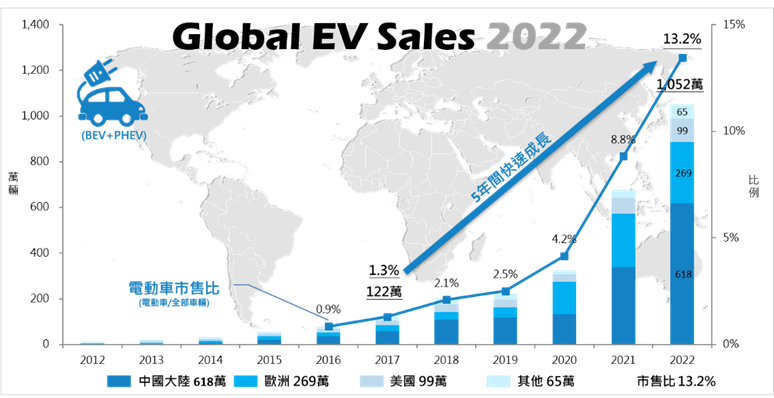Global electric vehicle market sales
2022 is a milestone year for the global electric vehicle market. After 10 years of promotion, global electric vehicle sales exceeded 10 million units for the first time, and from 1.22 million units in 2017 to 10.52 million units in 2022, in just 5 years The market has grown nearly 10 times. From the perspective of the Industry Life Cycle theory, the growth curve and values in recent years are very significant and typical signs of the "growth period". Looking forward to 2023, based on the sales volume in the first half of the year compared with the same period last year In comparison, the International Energy Agency (IEA) conservatively estimates that global electric vehicle sales may reach 14 million units in 2023, maintaining a high growth rate of approximately 35-40%.
Global market changing trends
"We are facing a major change like the transition from horse-drawn carriages to cars in the past," Honda President Toshihiro Mibe said at the 2022 strategy briefing. With the rise of electric vehicles, an easily overlooked but important point is that "fuel vehicles are disappearing." If we look at the market share of the global automobile market in terms of power sources (market-to-sales ratio), as shown in Figure 2 below, 97.8% of the global market in 2013 was fuel vehicles. It can be said that since fuel vehicles replaced horse-drawn carriages in the 1990s, this has For a century, fuel vehicles dominated the market. However, the proportion of pure fuel vehicles has dropped to 76.2% in 2022, which means that "more than 20% of fuel vehicles have disappeared" in just 10 years, replaced by electric vehicles and gasoline-electric vehicles. This is a sign of changes in the future market structure. Taiwanese manufacturers that serve fuel vehicles, from upstream components and downstream OEMs to dealers and warranty operators, must be aware that new industries are emerging. At the same time, old industries are also disappearing, and industrial transformation is imminent.
Energy recovery systems are changing with each passing day
To understand energy recovery, we first need to understand two parts. The first part is the motor of the electric vehicle. The motor can be called an electric motor when driving. That is, the electric energy of the battery is output to the motor, and the motor converts the electric energy into kinetic energy for output. The drive system of the car, that is, the wheels, completes the driving process. When the motor is connected to the power supply, the motor starts to work. The motor is a very magical thing. It does not only output kinetic energy like the traditional fuel engine. The motor can not only be used as an electric motor, but also can be used as a generator. Isn't it surprising? Yes, it's that magical. When the battery stops supplying power, when the motor passively rotates by external force, the motor can convert the kinetic energy of the external drag force into electrical energy, so the electricity recovered from the kinetic energy comes out.

